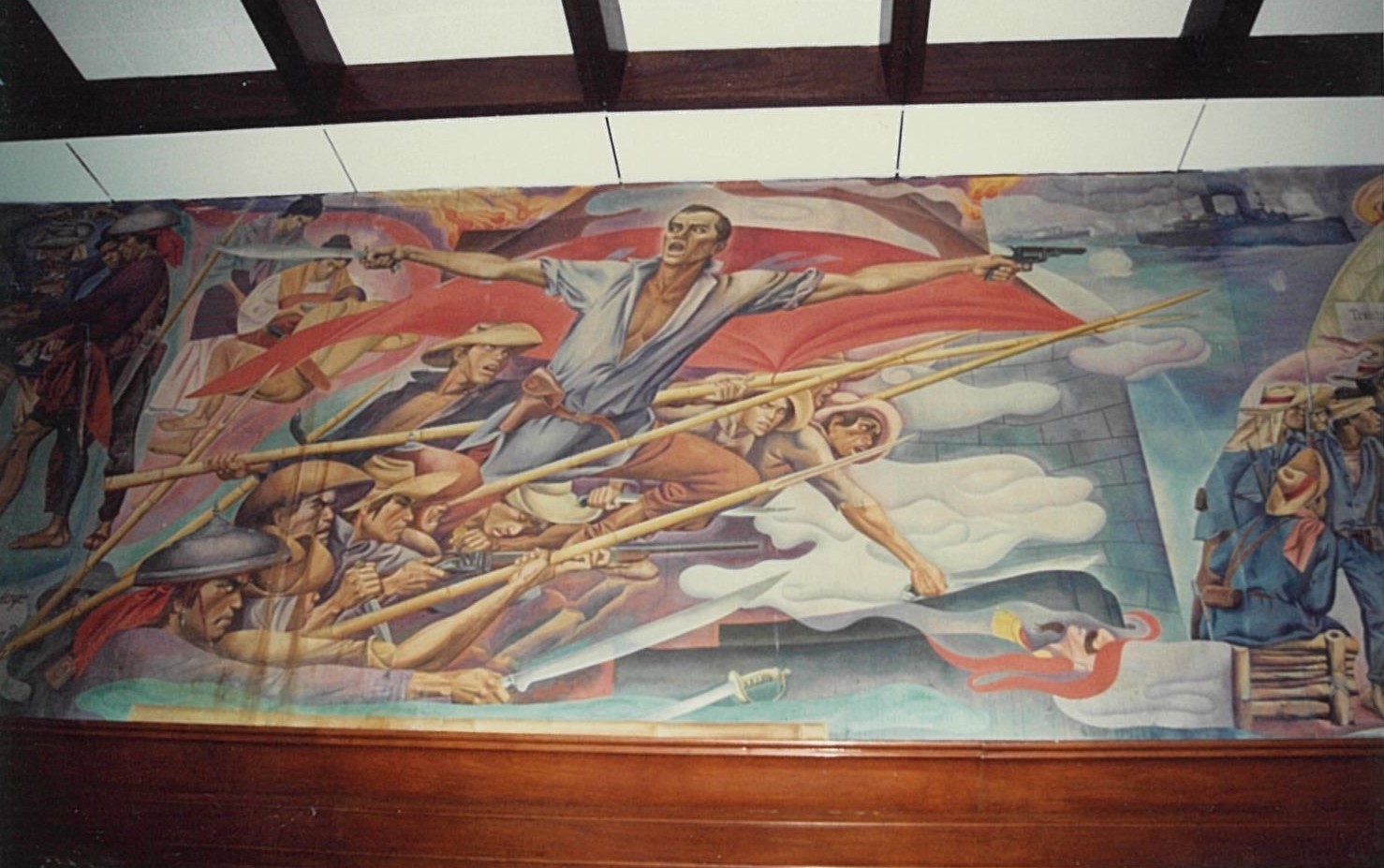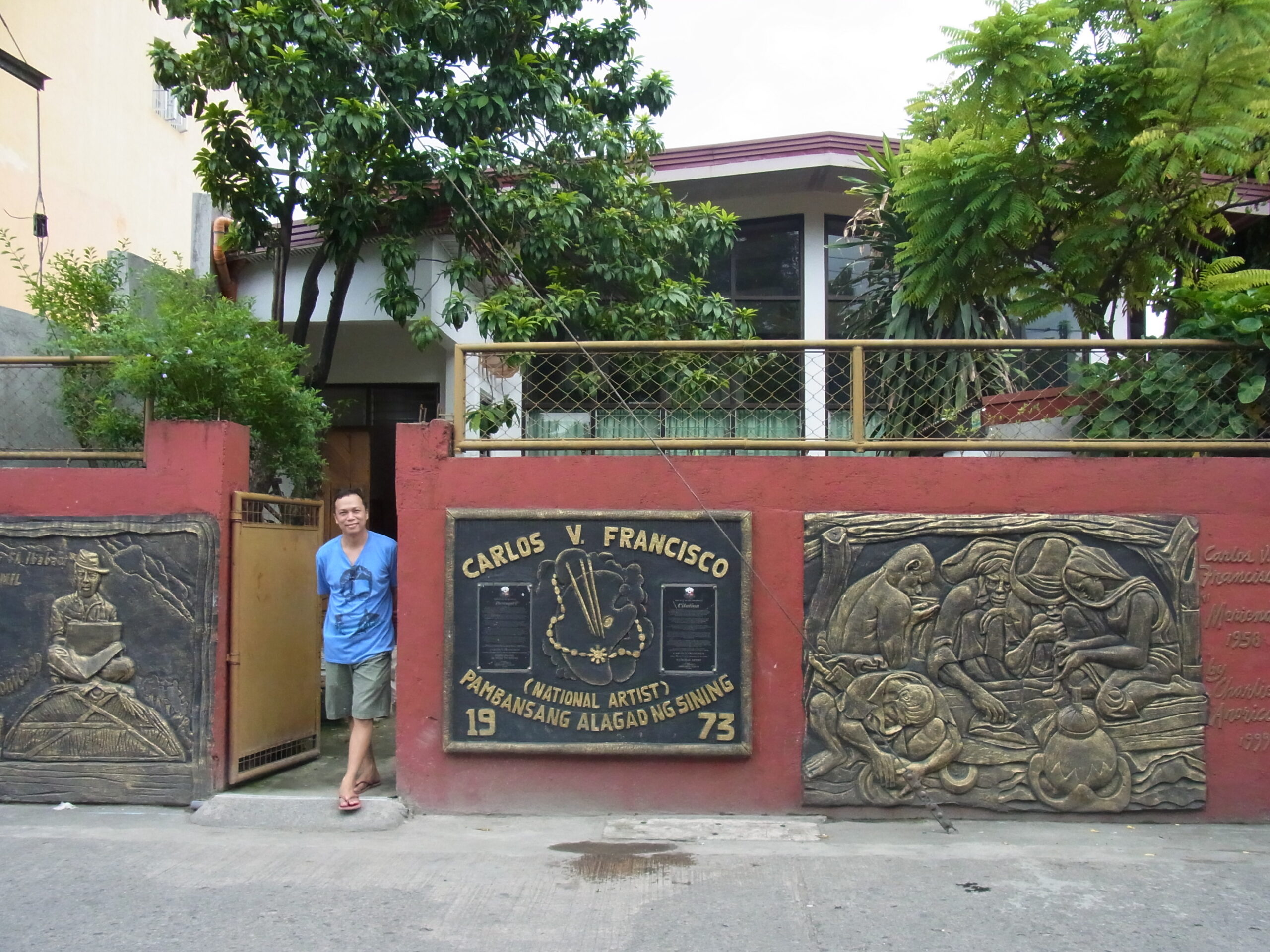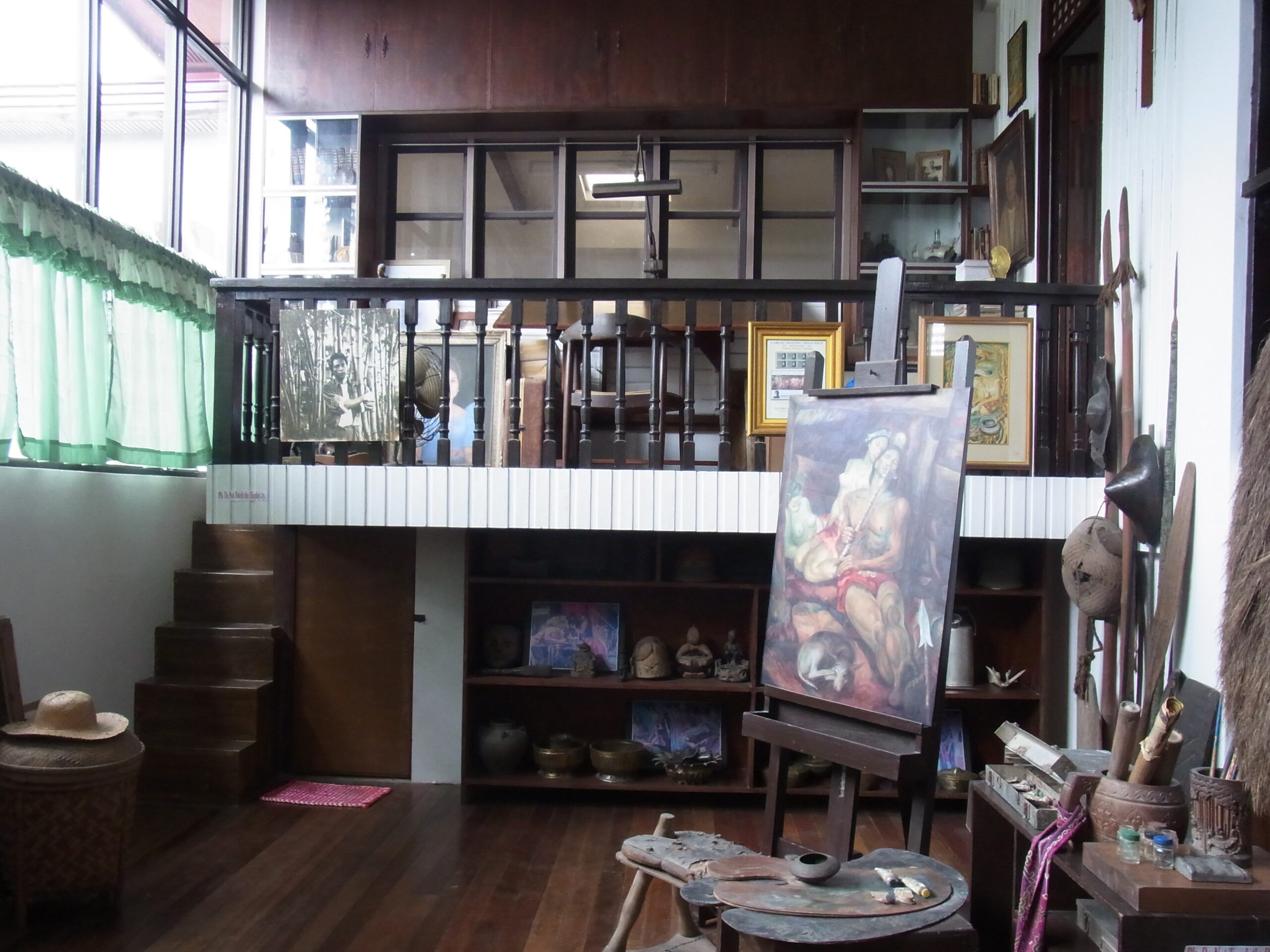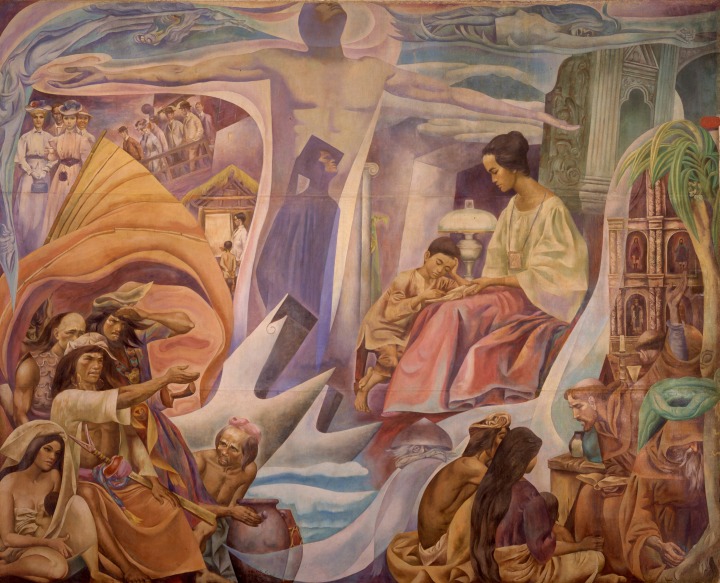Carlos “Botong” Francisco
Between the Nation-State and the People
- Name
- Carlos “Botong” Francisco
- Media
- Painting
- Region
- Philippines
- Year of Birth
- 1912
- Place of Birth
- Angono, Rizal, Philippines
- Year of Death
- 1969
- Place of Death
- Angono, Rizal, Philippines
- Link to Art Terms
- Link to Regions
-
Plate of artwork

Filipino Struggles Through History, 1964
Manila City Hall
Photograph by Ushiroshoji Masahiro, 2014

Francisco’s house in Angono (exterior), 2013
Totong, grandson of the artist, stands at the entrance.
Photograph taken and provided by Hitano Mayumi

Francisco’s house in Angono (studio), 2013
Photograph taken and provided by Hitano Mayumi


Issues of “national artists”
Carlos Francisco[1], affectionately known as “Botong,”[2] was posthumously awarded the title of National Artist by the Philippine government in 1973. Among the “Major Artists” featured on this site, many have either received similar honors, or have produced murals and sculptures for public spaces such as government institutions, universities, train stations, and airports. However, few embody the title as fittingly as Francisco. He was not only one of the pioneers of modernism, as a departure from Western academism, in Philippine art, but also transcended the pastoral romanticism of his predecessor, Fernando Amorsolo (1892–1972), in vivid portrayals of the Philippines’ history as a nation-state moving toward independence and progress. His clear compositions and accessible depictions brought these narratives to life in murals throughout public spaces. Despite his stature as a master of Philippine art, Francisco never had a large-scale solo exhibition.[3] Rather than confining his work to exhibitions limited in terms of time and place, he chose to reach a wider public through murals and publications.
Murals as Public Art
Francisco initially studied at the School of Fine Arts of the University of the Philippines, but became dissatisfied with the European-style academic training, which emphasized realism. However, his talent was soon recognized by Victorio Edades (1895–1985), a professor at the University of Santo Tomas, who invited him to take part in mural projects as part of a three-person team, called the Triumvirate, together with his friend Galo Ocampo (1913–85). Edades,[4] who had studied art and architecture in Seattle, became a leading voice of modernism after returning to the Philippines in 1928. He challenged the conservative art establishment by exhibiting works featuring real laborers rendered with fierce brushstrokes, defying academism both in style and subject matter.[5] The mural Rising Philippines, which the Triumvirate completed in 1934 at the Capitol Theater in Escolta, ignited fierce debate between conservatives and modernists. However, it eventually came to be accepted by both Filipino artists and the general public as the country’s first “modern painting.”[6]
In 1938, Francisco joined Edades, Ocampo, and others as one of the “13 Moderns,” helping to propel the modern art movement in the Philippines. This movement notably coincided with the Philippines’ first steps on the path from American colony to fully independent nation, which began with the establishment of the Commonwealth in 1935. In the broader context of nationalism, their murals played a role in celebrating the unique cultural identity of the Filipino people.[7]
Edades admired the Mexican muralists who rose to prominence after that country’s revolution, such as Rivera, Orozco, and Siqueiros, renowned for their monumental murals. Information that Edades shared about Mexican murals depicting the struggles and history of the people had a major influence on Francisco. One interesting aspect of Francisco’s career is his work as a newspaper illustrator, and his sharp ability to recall and differentiate details like clothing and facial expressions was later applied to his murals, enabling him to powerfully convey complex historical narratives and folk life. In the murals and large-scale paintings he produced single-handedly, he depicted figures with such clarity and distinctiveness, assigning each a specific role, that the results were broadly accessible and could be said to have mass appeal. His exceptional speed and precision in executing large works was another advantage.[8]
Francisco’s abilities also proved invaluable in the design of film sets and costumes. In Genghis Khan (1950),[9] directed by Manuel Conde, the first Philippine film to be screened internationally, he was entrusted with production design (art direction). He went on to contribute to numerous film projects, including co-writing screenplays, and through cinema, a medium for the masses, his artistic practice became increasingly recognized as “national” in character.
Unfortunately, most of Francisco’s murals from the 1930s have been lost. The aforementioned Rising Philippines was destroyed during World War II, and Five Hundred Years of Philippine History (1953), commissioned for the Philippines International Fair, is no longer extant. However, one of his largest works, Filipino Struggles Through History (1964), in Manila City Hall, still survives, and its scale is monumental, with a height of 2.7 meters and a total width of 20 meters. Meanwhile, Progress Through Education (1964), now in the collection of the Fukuoka Asian Art Museum, was originally produced as a mural for a private residence, but because it was painted on canvas and affixed to the wall, the work has remained preserved in its canvas form.
Styles
Francisco’s painting style was far removed from the orthodox European academic tradition. In his murals, Edades emphasized achieving harmony between architectural space and the inherent flatness of painting,[10] and he recognized this same approach in his assessment of Francisco’s art.
His murals recapture the spirit of Chinese paintings which are “flat and yet very deep.” Botong has discarded the traditional method of Western artists, of painting from one and only one point of view, or station point. He distorts space in the same way that Chinese and Persians of the twelfth century distorted space in their works. Figures and objects in the distance are painted at the top of the canvas and of the same size as those in the foreground, thus achieving the effect of tapestry. (Victorio Edades, In Pursuit of Powerful Art)[11]
Human forms are simplified and adjusted so as to fit harmoniously within the picture plane. Figures, objects, landscapes, and architecture are all depicted using subtle shading, without stark contrasts of light and dark. Both foreground and background are rendered in similar tones, so the densely arranged figures and objects, compressed within a shallow space, appear illuminated by bright, uniform light. One can detect the influences of modernist painting from Edades onward, Mexican murals, and the decorative styles of Art Nouveau and Art Deco, which spread around the globe. However, given Francisco’s beginnings as an illustrator for magazines and other publications, it is possible that he deliberately chose this straightforward style not out of concern for popular appeal but to clearly convey people’s facial expressions, clothing, and roles, prioritizing clarity over dramatic chiaroscuro or spatial depth.
People as Subjects
This simplicity connects to Francisco’s status as a “national artist,” widely known to the people as “Botong.” However, it should be noted that the concept of “national” in the Philippines encompasses numerous ethnic groups and languages. The Philippines differs from countries where a relatively small number of ethnic groups make up the majority, and where the population has rarely experienced invasion or domination by foreign powers, as is the case in Japan. Moreover, contemporary Filipino artists face particular difficulties in presenting traditional culture as a unifying identity distinct from the West (a common approach in many parts of Asia), as the Philippines endured over 300 years of Spanish colonial rule, the longest of any Asian nation. As a result, Catholic culture from the West has become so deeply ingrained that it now forms part of the country’s native traditions.
For Francisco, depicting the history of an innocent “people” before colonization and a self-determined “nation” after independence was a means of reclaiming Filipino identity. His vision of the nation not only encompassed prominent figures, from the hero of independence José Rizal to the authoritarian President Fernando Marcos, but also moved beyond the romanticized portrayals of farmers favored by his predecessor, Amorsolo. Instead, Francisco portrayed “the nation” as a collective whole, including intellectuals active in culture, the arts, science, and education; ordinary citizens engaged in agriculture,[12] fishing, and commerce; and the bearers of regional culture, such as practitioners of Christian and indigenous faiths and their associated rituals.
Throughout his life, Francisco particularly cherished the folk culture of his hometown, Angono. Situated on the northern shore of Laguna Lake, about 30 kilometers east of Manila (roughly a 90-minute drive), Angono is known today as a community of artists.[13] Francisco continually depicted the people and natural scenery of his village, contributed to the preservation of local traditions by producing floats and decorations for Catholic festivals, and devoted himself to educating local children and aspiring artists.[14]
Francisco never once traveled abroad,[15] and chose not to engage with international art movements. A provincial artist with relatively dark skin,[16] he opted not to live in the metropolis of Manila, hold exhibitions, or sell his work to wealthy art collectors. Instead, following the example of Juan Senson (1847–1942),[17] an earlier painter from Angono, he wanted his art to be loved by the people of his hometown.[18] Over time, Francisco’s work contributed to an idealized view of Angono as a place preserving the “rustic” original culture of the Philippines, framed in contrast to Manila, which was seen as tainted by modern urban influences.[19]
However, Francisco’s focus on the harsh realities of laborers’ lives, as seen in Camote Eaters (1946),[20] was gradually pushed to the margins in his large-scale paintings and murals after the 1950s. Instead, these works primarily celebrated nation-building and presented history as driven by heroic figures such as Lapu-Lapu, who resisted Magellan’s Spanish forces, as well as José Rizal and Bonifacio, who spearheaded the movement for independence from Spain. Francisco’s historical perspective may seem outdated when viewed alongside the new historiographical approaches that emerged after the 1960s, which highlighted the roles of anonymous masses as the real engines of history, or industrial development as more influential than political leadership.[21] Furthermore, his history paintings reflect a stereotypically male-centric view of gender roles, with vigorous, active men occupying the public sphere, while women are portrayed in domestic roles, devoted to housework and childrearing, and female figures taking center stage only in mythological scenes. Some accounts[22] suggest that Francisco favored depicting muscular male figures over more “feminine” forms. Indeed, in Progress through Education, women are confined to roles as mothers or teachers, while it is men who are shown advancing the nation-state through scholarship and portrayed as the principal agents of history.
Distance from Politics
When viewed through a political lens, Francisco’s emphasis on peripheral figures and fine details,[23] as well as his rejection of one-point perspective (which can be seen as linked to an Orientalist gaze), has been interpreted as a form of “decolonizing the landscape.”[24] However, any attempt to infer Francisco’s personal political stance requires a cautious, nuanced reading of his paintings. One thing that is certain, however, is that throughout his career, his work continually shifted between the grand narrative of the “nation-state” and the smaller, more intimate narrative of “the people.”[25]
Francisco’s last major work, The Life of Ferdinand E. Marcos (1969), is a monumental painting, commissioned to commemorate Marcos’s re-election as president in 1965, depicting key episodes from his life. The composition, divided by swirling curves, traces a heroic narrative from the outer edges toward the center, through his university studies, athletic pursuits such as boxing and swimming, resistance against the Japanese occupation and subjection to torture, culminating in a central portrait of Marcos. The painting also celebrates the achievements of First Lady Imelda Marcos, including her role in establishing the Cultural Center of the Philippines. However, by 1971, just two years after Francisco’s death, the Marcos regime was facing growing opposition. Student protesters and the New People’s Army ignited large-scale demonstrations, known as the First Quarter Storm. Politically engaged artists also took a stand, forming NPAA ’71 (Nagkakaisang Progresibong Artista at Arkitekto ’71 [United Progressive Artists and Architects ’71]) that same year. The following year, Marcos declared martial law, and with American backing, maintained an anti-communist dictatorship for over a decade until his regime was ultimately toppled by the 1986 democratic uprising known as the EDSA (People Power) Revolution. One wonders what sort of history paintings Francisco might have produced had he not died at the young age of 57, and had he lived to witness this moment when “the people” triumphed over the “nation-state.”
(Kuroda Raiji, translated by Christopher Stephens)
[1] His full name was Carlos Modesto Villaluz Francisco.
[2] He was widely known by the nickname “Botong,” after a local clown with a similarly dusky complexion.
[3] D. M. Reyes, “Miracle of Rare Device,” The Life and Art of Botong Francisco, Patrick D. Flores (ed.) (Quezon City: Vibal Publishing House, 2010), 72.
[4] While Edades was studying at the University of Washington in Seattle, the Armory Show in New York (1913) was much discussed as America’s first substantial introduction to European avant-garde art, and notorious for the furor surrounding Marcel Duchamp’s painting. However, Edades did not gravitate toward Dadaism, and was instead influenced by works exhibited there by the Ashcan School which realistically portrayed ordinary people. Rod. Paras-Perez, “Once More with Feeling,” Edades and the 13 Moderns (Manila: Cultural Center of the Philippines, 1995), n. p.
[5] Edades conveyed the value of modern art to Filipino intellectuals and the general public through media debates and written contributions. Alice G. Guillermo, “The Triumvirate,” The Life and Art of Botong Francisco, 99. For Edades’s defense of modernism, see: Victorio Edades, “Liberation from Academism,” in Ushiroshoji Masahiro and Toshiko Rawanchaikul (eds.), The Birth of Modern Art in Southeast Asia catalog (Fukuoka Art Museum, 1997), 202–204.
[6] Guillermo, 96, 97.
[7] Guillermo, 84, 96.
[8] Reyes, 61.
[9] It was screened worldwide after the Venice Film Festival in 1952, and was also featured in the Philippine Pavilion at the Venice Biennale in 2015. See: Tie A String around the World, Patrick D. Flores (ed.) (Manila: The National Commission for Culture and the Arts, The Department of Foreign Affairs, and The Office of Senator Loren Legarda, 2015). https://philartsvenicebiennale.org/2015/05/09/tie-a-string-around-the-world/
[10] Quoted in Guillermo, 90.
[11] Victorio Edades, “Toward Virility of Arts,” Newsweek (September 26, 1948), quoted in Flores, 30 and Manalo, 169 (there are slight differences in the quote’s content and source).
[12] Manalo also points out an interesting difference compared to Amorsolo: in Francisco’s works, farmers cultivate the land using tools such as bamboo poles, whereas in Amorsolo’s paintings, they are typically shown working the fields with their bare hands. Manalo, 201.
[13] For information about Angono, see: Philippine Art Guidebook Project (Nakanishi Miho, Yamagata Ryoko, Furusawa Yuria, Saito Urara, eds.), Philippine Art Michikusa Guide: Manila Edition (Philippine Art Guidebook Project, 2013), 82–90.
[14] Patrick D. Flores, “If Memory Serves,” The Life and Art of Botong Francisco, 15; Reyes, 65–66.
[15] Reyes, 72–73. Francisco continuously declined invitations from abroad, even giving up his only opportunity, a visit to Mexico to meet the painter Diego Rivera, whom he admired, due to a high fever.
[16] Botong’s complexion differed from that of his fair-skinned sister. Additionally, as a native of a provincial area, he may have faced discrimination in Manila. Manalo, 166.
[17] His work is reproduced in Realism in Asian Art, Kim Inhye and Joyce Fan (ed.), (The National Museum of Contemporary Art, Korea, and The National Art Gallery, Singapore, 2010), 34–35.
[18] Manalo, 209–210.
[19] Manalo, 157.
[20] Reproduced in The Birth of Modern Art in Southeast Asia, 40.
[21] Roberto G. Paulino, “Visualizing Philippine History: Image and Imagination in Murals,” The Life and Art of Botong Francisco, 110–135.
[22] Flores, 13.
[23] Ino M. Manalo, “Angono: Hometown as Subversion,” The Life and Art of Botong Francisco, 177.
[24] Ino M. Manalo, 172.
[25] During the Japanese occupation of 1941–45, Francisco, along with other Filipino artists, interacted with Japanese artists. In 1942, he attended a reception also attended by painters such as Mukai Junkichi, Abe Yoshifumi (Nobuya), Inokuma Gen’ichiro, Sato Kei, and the novelist Hino Ashihei. In 1944, he won first and second prizes at the 2nd National Art and Architecture Competition (Edades was one of the judges). However, his thoughts on Japan’s “Greater East Asia Co-Prosperity Sphere” remain unknown.